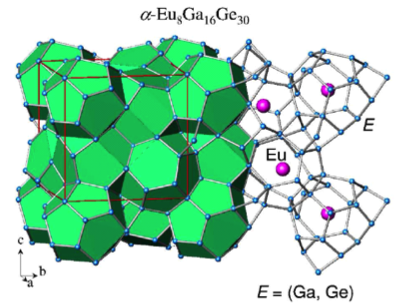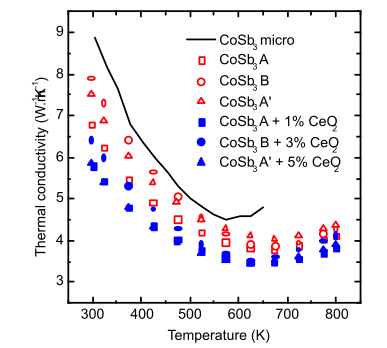Energy and Quantum Materials
Thermoelectricity and Magneto-calorimetry
Researches on thermoelectric have re-gained interest in recent years, using an approach of ‘material design’, where on tries to ‘tailor’ the atomic structure of the compound in order to obtain desired physical properties.
Indeed, in designing new thermoelectric, the main concept is the tailoring of phonon thermal conductivity while keeping intact the semi-conductor type electronic properties. Indeed the efficiency of thermoelectric is inversely proportional to the thermal conductivity (everything else being fixed). This can be achieved by two main routes that will be explored:
(i) Grain size reduction and nanostructuring, which reduces the thermal conductivity without affecting electrical properties as the typical length scales are quite different. First interesting results have been obtained in the CoSb3 [1]. A partnership with industry has been set up.
(ii) Cage compounds: clathrates and skutterudites: in this case the reduction of thermal conductivity is driven by the atomic structure where a heavy atom is weakly bonded to surrounding ones forming a cage. Fundamental researches and a first demonstrator set up have already been carried out within the European Integrated Center [2-5]. Basic researches will be continued, but effort towards innovation will be also carried out in particular by contacting new partners having an expertise in this field.
Researches are also carried out for magnetocaloric materials, designing new alloys allowing cooling using heat sink [6].


Figure 1 : Crystal structure of the Clathrate a-Eu8Ga16Ge30. A heavy element – Eu -is inserted into the cages. Right panel: Evolution of the thermal conductivity of CoSb3 as a function of grain size and temperature
1. E. Alleno, L. Chen, C. Chubilleau, B. Lenoir, O. Rouleau, M. Trichet, and B. Villeroy. J. Electron. Mat. 39, 2010, 1966.
2. M. Reissner, E. Bauer, W. Steiner, P. Rogl, A. Leithe Jasper, Yu. Grin. Skutterudites, a thermoelectric material investigated by high field Mosssbauer spectroscopy. Hyperfine Interact. 82, 2008, 15-22.
3. E. Alleno, G. Maillet, O. Rouleau, E. Leroy, C. Godart, W. Carrillo Cabrera, P. Simon, Yu. Grin. Germanium Vacancies and Charge Transport Properties in Ba8ZnxGe46-x-y□y. Chem. Mat. 21, 2009, 1485-1493.
4. U. Aydemir, C. Candolfi, H. Borrmann, M. Baitinger, A. Ormeci, W. Carrillo‑Cabrera, C. Chubilleau, B. Lenoir, A. Dauscher, N. Oeschler, F. Steglich, Yu. Grin. Crystal structure and transport properties of Ba8Ge43□3. Dalton Trans. 39, 2010, 1078-1088.
5. L. T. K. Nguyen, U. Aydemir, M. Baitinger, J. Custers, A. Haghighirad, R. Hofler, K. D. Luther, F. Ritter, Yu. Grin, W. Assmus, S. Paschen. Physical Properties of Single Crystalline Ba8Ni3.5Ge42.1□0.4. J. Electron. Mat. 39, 2010, 1386-1389.
6. B. Podmiljsak, P. J. McGuiness, N. Mattern, H. Ehrenberg, S. Kobe. Magnetocaloric properties in the Gd5(Si2Ge2)1-zFez (z = 0-0.75) system and the magnetic properties of the newly formed Gd5(Si,Ge)3 phase. IEEE Trans. Magn. 45, 2009, 4364-4367.
RAD leaders: S. Bühler-Paschen and E. Svanidze
